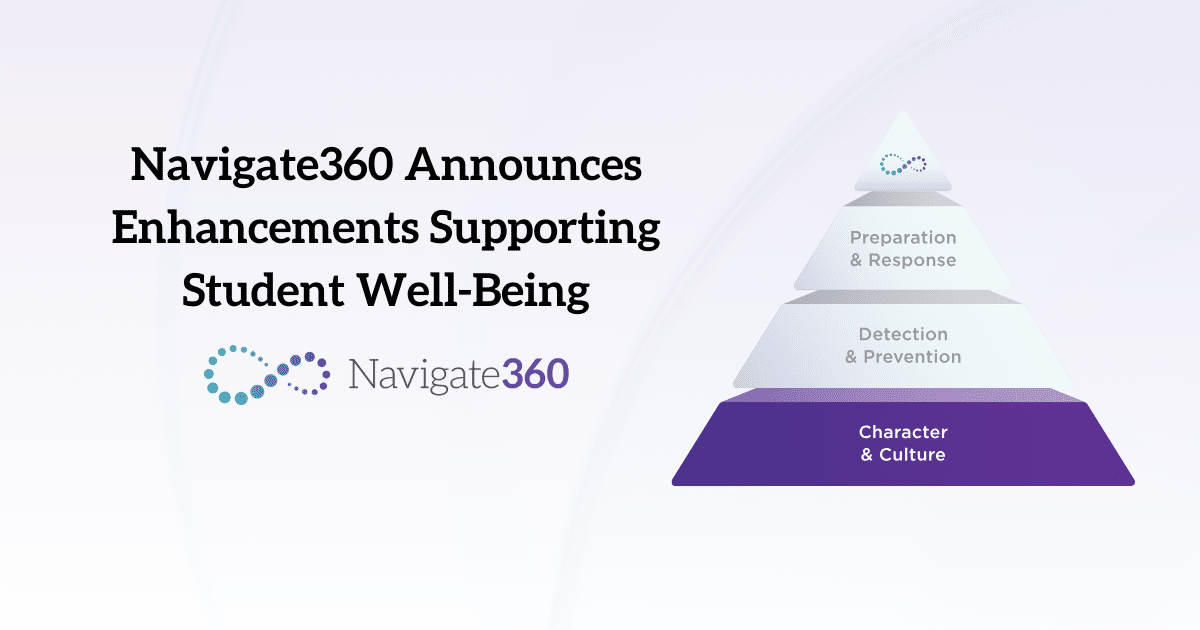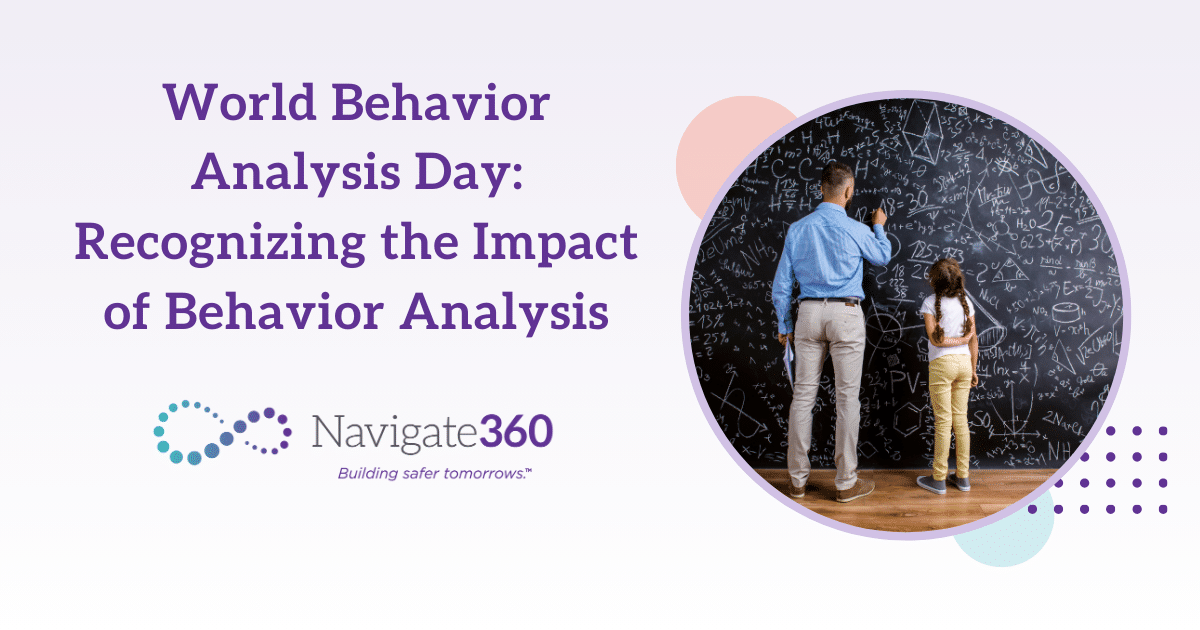Navigate360’s Chief Learning Officer Melissa Ragan and Escambia County School District Coordinator for Student Engagement Jeremy Tompkins tackle some of the most frequently asked questions about social-emotional learning, including questions about collaboration between students, educators and families. Read their expert insights below, and don’t hesitate to contact us via chat or by using this form if you have any additional questions.
SEL Curriculum
Q: Integrating and prioritizing SEL within our master schedule is a challenge. The district knows it’s a need, but the implementation of it across schools is not consistent. How can we address this?
JEREMY TOMPKINS: In our county, there is a specific time set aside for SEL instruction at the elementary and middle school level. This is normally done in small group time at elementary schools and at middle school, they do a research/homeroom period in which SEL instruction is given. High school is a little different due to the curriculum demands. We have a couple of high schools that have created an excel period during lunches in which they use this time for SEL curriculum instruction. The other high schools use the SEL curriculum as interventions in ISS and ILR classrooms.
MELISSA RAGAN: Research suggests that for students to get the maximum benefit of social-emotional learning, consistency and ongoing opportunities to practice these new skills is important. Finding time to do this is a common issue for schools and districts across the country. We’ve had districts address this challenge in a variety of ways. Some do SEL during homeroom, advisory, or health. Other schools have SEL as a separate offering altogether or embed it into core classes, such as ELA. However it’s done, it’s important that schools build a common language and use the skills and strategies throughout the day in every classroom and with every interaction with students.
Q: Where are the tangible SEL activities we can work on one on one with students?
TOMPKINS: We use Navigate360 in our schools to provide the SEL curriculum. Those tangible resources you are seeking are built into that curriculum. Those resources are user-friendly to students, parents, staff, and administrators. The other great thing is it is designed to fit the specific needs of your school or school district.
RAGAN: Using a comprehensive SEL curriculum, such as Navigate360 SEL, is an easy way to work on building students’ SEL competence. As students work through the lessons, you can look at the assessment data and identify where students need help and then work one on one with those students in those areas. But if your school can’t purchase an SEL curriculum, there’s still hope. Good teachers are already doing SEL in their classrooms. They are building relationships with students, helping students resolve conflicts, encouraging collaboration in group activities, and checking in with students when they don’t seem like themselves. Of course, you can also find a lot of good material online, but you’ll have to sift through a lot of weeds to find the flowers. Greater Good from Berkley and UNESCO come to mind as places to get great free resources. .
Students and SEL
Q: I understand students’ anxiety and lack of coping skills, but how do we help the students when the students are physically and mentally abusing teachers? Teachers are leaving the profession because of the anxiety and fear that students are causing us.
TOMPKINS: In our district, we take a very strong stance on protecting our teachers. That has to be the first priority. However, that does not mean we put the needs of that student to the side, either. I think we know discipline-wise there may be a need to move a student to an alternative placement for abusing a teacher, but in our school district, we still provide resources to those students while at the alternative placement location. They receive Navigate360 SEL for Mental Health training, access to a mental health counselor, and a school social worker. These resources help us to prepare the student to return back to traditional school with the tools that they need to be successful.
RAGAN: Using a restorative circle with all the parties who were affected by the behavior can be really healing for everyone. It puts the focus on identifying the harm that was done (how did the action/abuse impact others) and how the harm can be repaired instead of focusing on the rules or policies that were violated and which consequence/punishment is going to be utilized. Allowing the person/people who were affected by the behavior to speak to how it personally impacted them can be healing for them AND it can give a powerful perspective and insight to the student who engaged in the behavior that they wouldn’t have if the incident was never processed. A restorative circle also lets the student’s voice be heard so that there can be an understanding of why the behavior occurred. We often focus so much on the rules and the punishment that we miss the opportunity to understand what the behavior’s function was. Then the conversation can address what can be done so that it doesn’t happen again. What type of intervention or accommodation does the student need? Is there an underlying skill that is missing, is there a need that’s not being met, is there a trigger that can be eliminated? Restorative circles help all parties to understand each other and be able to move forward with a strengthened connection.
Q: For many students, coping and behavioral skills have regressed since COVID-19. How can school staff address their social-emotional needs while also busy with their day-to-day schedules?
TOMPKINS: I think the greatest SEL tool that educators have is the ability to listen and have empathy for their students. I think everything starts at that point. If we are in tune with our students and the struggles they are facing, lasting relationships are built. The relationship is what will drive the student to let their guard down, and that is when the multiple SEL resources that are available can be used to make a lasting change in the student.
RAGAN: As Jeremy mentioned, teacher-student relationships are so important. Having empathy is essential. But being a little vulnerable with your students is important, too. Talk to them about how you’re feeling. Let them know you are worried, too. Share your favorite coping strategies with them. I find that engaging in mindfulness activities can help students self-manage. Offering to meet with students before or after school or at other times just to show you care can also make a big difference.
Q: I am very concerned about the time kids were able to spend on their phones, with easy access to dangerous content. I’ve seen kids not know how to deal with the things they’ve been exposed to. Are there any resources you would recommend for this?
TOMPKINS: I will say that phones and technology, in general, are a common problem across the country. The Navigate360 SEL curriculum does have content that deals with social media use, cell phones, and technology issues. I would encourage you to review the content.
RAGAN: I share your concerns as a parent and as an educator! There are products available for schools that help to filter content that kids have access to while at school or when using devices owned by the school. Contact us to learn more about our solution for that. In addition, Common Sense Media has some great (and free) resources to help.
Educators and SEL
Q: Getting teacher “buy-in” is so challenging. How can we show that SEL and academics are connected in student success?
TOMPKINS: There are studies that show that if students feel safe in their school environment, then academic performance increases. Schools that also have a lower out-of-school suspension rate tend to do better academically. A strong SEL program will help to promote a safe school environment and will help to lower out-of-school suspension by teaching character development but also by helping to teach appropriate school behaviors to their students.
RAGAN: CASEL has quite a few research studies that document the positive academic gains associated with SEL. For some teachers, that’s enough, but some people need to experience it themselves. Typically, if a teacher uses a high-quality SEL program for at least a month, they will begin to see the benefits themselves. Sometimes that will come in the form of changes in a single child. At other times, that may come in the form of fewer classroom disruptions. Training is also important. When I was training to become a teacher, SEL wasn’t part of the training. Teachers can’t buy into something they don’t know about, so making sure they have the background knowledge about SEL is essential.
Q: Some educators don’t want to shift their mindset to help with challenging behaviors. They prefer the punitive approach. How can we combat this?
TOMPKINS: I think this takes time. The best way to change a mindset is to show them by example that it works. We have been able to make major strides in this area over the past 13 years due to the vision of our current and former superintendents.
RAGAN: Information is power. If you have a teacher who is reluctant to change their practices, it often takes repeated exposure to get them on board. This may occur as they hear success stories from other teachers at the school or personal experience if a district or school requires SEL.
Q: What are some suggestions for improving teachers’ understanding of the importance of SEL, not only for students but for themselves?
TOMPKINS: I think where we showed the most growth in this area is when we added the Navigate360 SEL for Mental Health curriculum for our students to meet our governor’s Mental Health Mandate. As the teachers taught the curriculum to the students, it began to help them with some challenges they were facing. Then, as a district, we were able to provide resources to help them. This has only grown in importance as anxiety and stress have increased exponentially during the pandemic.
RAGAN: Research shows that teachers understand the importance of SEL, but they don’t have enough training. Conversely, studies show that teachers who reported higher levels of wellbeing used SEL practices more often than those who didn’t. I honestly think that most teachers already understand the importance of SEL for themselves, but they fail to act on it. Teachers are natural helpers – often at the expense of themselves. Unfortunately, that’s part of the reason that we see high rates of teacher burnout and the high levels that we see today of teachers leaving the classroom. I don’t think the problem is teachers not understanding that SEL is important. It’s that they don’t prioritize themselves and their own SEL and self-care. I love hearing stories about how administrators do things to support teachers in this way to help them learn to prioritize themselves. Taking over a class or duty for them, coffee, little notes of encouragement or gratitude, support, and a few minutes to breathe during the day can go a long way.
Q: Teachers at my school are looking for classroom strategies to correct behaviors. Support staff are doing a lot to help teach skills in push in/pull out sessions. Are there strategies or supports that would help teachers in the moment?
TOMPKINS: With Navigate360 SEL, teachers have access to the intervention curriculum. In our district, we use this curriculum in both our ISS and ILR classrooms. Students complete lessons on the behavior that placed them in the classes. Every lesson has a pre- and post-test and the teacher can set the passing score. In addition, each lesson has a reflective writing piece within it. We see decreases in repeat negative behaviors as a result of the use of the intervention curriculum and other restorative practices being used in the classes.
RAGAN: In addition to intervention lessons like those that Jeremy mentioned and traditional PBIS supports, I also encourage teachers to try emotions coaching. This is a parenting strategy which can be used to help the student identify exactly what they’re feeling, why, and the most appropriate behavior or reaction to this feeling. This can take some time and patience to implement and may require some modeling by the teacher. But by making emotions a priority in the class helps students feel seen and heard, helps with self-regulation, and will ultimately lead to a more positive classroom climate.
Q: What’s the best way to balance teacher needs and anxiety to get through the curriculum but also give transition time for SEL needs?
TOMPKINS: I think the best way is by using the curriculum in a common research or homeroom period as not to take away from a subject-specific instructional time. This also allows for student/teacher relationship building because of the discussions that will be generated from the curriculum.
RAGAN: It’s a valid concern, especially with so many demands placed on teachers. But SEL shouldn’t be seen as another item on their plate. SEL is the plate. When students are better equipped to manage their social, emotional, behavioral, and mental health, then research shows they are better able to focus on academics. There is less time lost to dealing with disruptions and challenging behavior. It takes less time to practice SEL than it does to deal with behavior problems.
Family/Home Life Collaboration
Q: Family education is an integral part of the process in any program that we want to implement so that parents can support our efforts when the students are home. Some parents are averse to any “mental health” supports that schools and the community offer at times. How do you get parents on board?
TOMPKINS: I think fundamentally parents want to help their students be successful. Some parents just do not know how. Providing resources to them at home so that they can assist their student is valuable. Navigate360’s SEL program gives the parents access to these resources through the parent portal. The curriculum then gives parents the tools needed to open up communication with their students on these difficult topics. The school district must then be ready to provide or direct families to additional mental health resources.
RAGAN: The most effective way to assure families and get them on board is by being transparent. When parents have access to the lessons that their students are using, it helps to ease their fears and promotes important conversations at home, not just at school.
Q: Some of my students’ trauma stems from their home life. Can SEL help in those situations?
TOMPKINS: Yes, I think that this is what SEL is meant to do. But again, schools need to be ready to offer mental health services for these students over time to help them deal with the issues they face.
RAGAN: Yes! SEL is about self-awareness, self-management, social awareness, relationship skills, and responsible decision-making in all aspects of life. As students learn these skills and learn how to apply them in different contexts, including learning when and how to seek help, it strengthens their ability to positively impact their own environments.
Restorative Practices
Q: Can you speak more about specific examples of restorative practices you use?
TOMPKINS: We are Capturing Kids’ Hearts trained. We use trauma-informed care, Morning Chats, Mental Health First Aid, Navigate360 SEL for Mental Health, and Roadmap to Responsibility (Larry Thompson) to name a few.
Q: How can restorative practice be worked into the day when time is extremely limited?
TOMPKINS: Time is always going to be limited. It just has to be made a priority at all levels of your school district. As mentioned, setting aside a common research or homeroom time is very effective.
RAGAN: Restorative practices can be built into the day. Teachers need to look at it as a time saver instead of a time waster. Think about how much time is spent dealing with behaviors. Restorative practices are preventive and help students build a sense of belonging and community so they won’t want to act out. Yes, restorative practices take time, but behaviors take more time. Also, I don’t agree with the principal handling the follow–up. It’s more important for the teacher to handle it and have the principal or someone else step in to manage their class. When the principal steps in, the teacher and student never get any closure or mutual understanding that can improve the relationship.
Q: What is the best way to track behavior/discipline referrals?
TOMPKINS: On this question, I can only speak for our district. We have FOCUS as our Student Information System. FOCUS built within it a system called FOCUS Analytics. This system puts live time data at the fingertips of every dean and administrator in our district. Having this information readily available helped schools to have weekly discipline discussions and see trends that they need to address at their schools quickly.
Navigate360 Social-Emotional Learning
Q: Is Navigate360 Social-Emotional Learning evidence-based?
RAGAN: Yes, Navigate360’s SEL solution is based on a comprehensive research base. We have data indicating significant gains across CASEL competencies on our pre/post measure as well as anecdotal evidence of improvements in attendance and decreases in suspensions.
Q: Does the Navigate360 program depend on reliable internet?
RAGAN: While access to the independent student lessons do require Internet access, the Teacher Companion Guide is a printed resource that can be used when Internet is not available. In addition, some lessons include graphic organizers that students can use when Internet access isn’t reliable. We also have Classroom Conversation Cards, which help facilitate student-led conversations about SEL topics.
Q: Does Navigate360 SEL connect to Google Classroom?
RAGAN: Navigate360’s SEL solution does not currently integrate with Google Classroom, but it does work with many SSO platforms, including Clever and Canvas.
Contact us today to learn how Navigate360 Social-Emotional Learning can help your school improve student behavior, foster mental health and create a more positive school climate.




